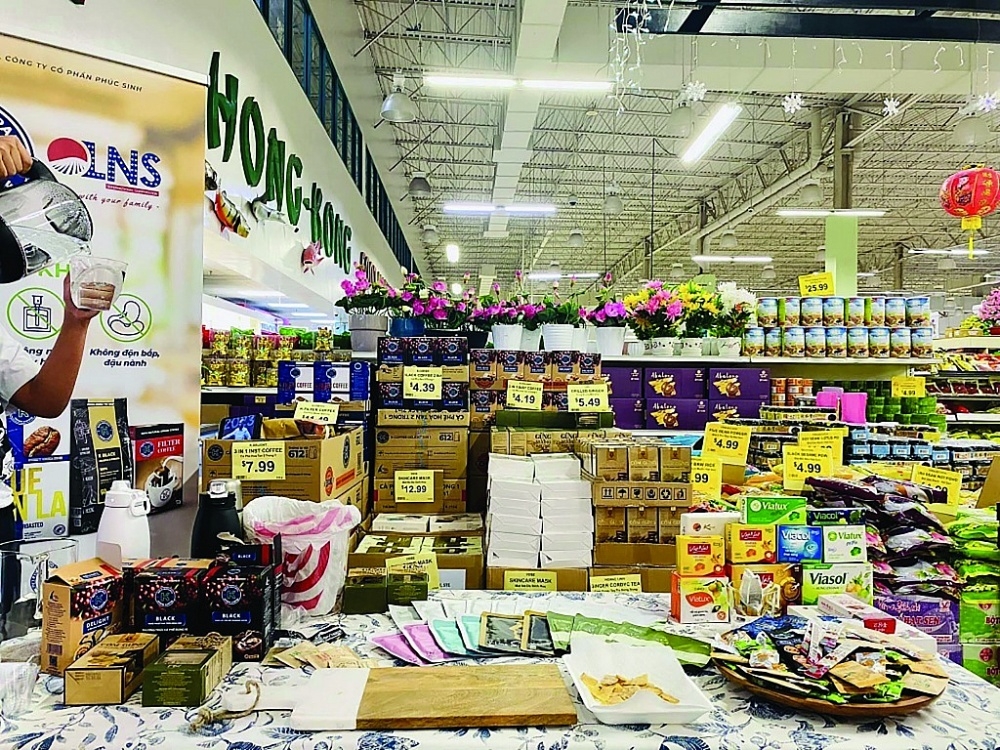Vietnamese goods confidently conquer domestic market
The scale of Vietnam's retail market has exceeded 180 billion USD in 2023 and is forecast to maintain positive growth in the following years. Meanwhile, many industries such as textiles and garments, leather - shoes, electronics... only supply domestic demand with 10% of output, the remaining 90% of output is for export. The influx of foreign goods into the market is also challenging Vietnamese goods. Therefore, many solutions are needed to increase the competitiveness of Vietnamese goods in the domestic market - a solid base amid the chaotic export market.
 |
|
Many Vietnamese products are on the shelves of US supermarkets. Photo: TL |
Transformation from awareness
Ms. Le Viet Nga, Deputy Director of the Domestic Market Department (Ministry of Industry and Trade) said that after more than 14 years of implementing the Campaign "Vietnamese people prioritize using Vietnamese goods", Vietnamese goods have outburst strengths (namely for essential goods and consumer goods) has been and continues to cover a wide range of distribution networks, from traditional distribution channels to modern distribution systems.
According to local reports, in the supermarket systems of some domestic enterprises, domestically produced goods account for a large proportion of 80 - 90% such as Co.opmart (90%), Winmart (90%) , BRG Retail (80-90%)... Foreign-invested distribution systems such as Aeon, Central Retail, MMMegaMarket, LotteMart... also make many efforts to contribute to the community where they open their businesses by purchasing and supporting the promotion of consumption of local products and regional specialties (OCOP products, typical rural industrial goods, local staple goods, etc.) and keeping a high proportion of Vietnamese goods in its distribution channels.
According to the representative of the Domestic Market Department, the efforts of ministries, branches and localities, including the Ministry of Industry and Trade, in connecting supply and demand, trade promotion, and stimulating consumption of Vietnamese goods have contributed considerably to maintaining the growth of domestic trade and supporting output for domestic production.
Total retail sales of goods and consumer service revenue in November were estimated at 552.7 trillion VND, up 1.4% over the previous month and up 10.1% over the same period last year. In the first 11 months of 2023, total retail sales of consumer goods and services at current prices were estimated to reach 5,667 trillion VND, up 9.6% over the same period last year.
“The domestic market has contributed to the growth of manufacturing and processing industries as well as agricultural, forestry and fishery production and processing, contributing to creating jobs and ensuring social security for people. ", Ms. Le Viet Nga is valuable.
Sharing the same opinion, Ms. Nguyen Thi Thu Thuy, Standing Vice President of the Vietnam Association for Consumer Goods Development (VACOD), said that capturing and responding to consumer trends is a key factor for businesses to produce products. Consumer goods production can compete and develop at any time and in any country. Ms. Nguyen Thi Thu Thuy emphasized three current consumer trends of Vietnamese goods, including: e-commerce and multi-channel shopping experience; in favor of consumption of high quality Vietnamese goods; Green, sustainable consumption, prioritizing Organic ones - natural and healthy products.
According to a VACOD representative, Vietnamese consumers also want to have a multi-channel experience when shopping online. Young people are greatly influenced by social networks, especially their consumer behavior is dominated by platforms: Shopee, Instagram, YouTube, TikTok... Gen Z is especially influenced by social media content about skin care and makeup, accessories such as jewelry and shoes... A very large proportion of older consumers have now become accustomed to purchasing remotely through digital services.
Besides, according to Ms. Nguyen Thi Thu Thuy, aware of the importance of sustainable development of the domestic market, Vietnamese businesses in recent years have constantly strived to improve product quality and diversity types of business so that products are most accessible to consumers.
“In 2023 alone, there were 519 businesses certified for high quality Vietnamese goods voted by consumers. The whole country currently has 63/63 provinces and cities evaluating and classifying OCOP products. 10,881 OCOP products have been evaluated with 3 stars or more... At the same time, Vietnamese consumers are increasingly prioritizing the use of high quality domestic products. According to research by Cimigo market research company, 82% of Vietnamese consumers said they would prioritize buying Vietnamese products if they had a choice," a VACOD representative gave an example.
In particular, Vietnamese consumers are increasingly concerned about environmental, social and health-related issues, prioritizing clear origins and environmental friendly ones. In spite of raising input costs, they are widely favored thanks to health and ecological benefits According to a survey PwC Vietnam recently conducted on "Consumer habits" and the results show that today's consumers are more concerned about the environment. More than 47% of survey participants said they prioritize using biodegradable products.
Expanding overseas markets without neglecting domestic market
Accessing consuming trends facing challenges to the production and consumption of Vietnamese goods in the domestic market, Ms. Le Viet Nga said that many imported products are tending to shift strongly into the domestic market. consumption in the domestic market after new generation Free Trade Agreements (CPTPP, EVFTA...) officially take effect. This is also a huge challenge for domestically produced goods in the context of general integration.
"The proportion of imported goods in the distribution system, especially cross-border e-commerce channels, will likely increase in the near future," Ms. Le Viet Nga informed.
In addition, digital and e-commerce platforms are growing rapidly over the years and dominate the market with a growth rate of more than 20% per year. According to Metric's statistics, in the first 6 months of 2023, 3 foreign platforms including Shopee, Tiktok Shop, and Lazada accounted for 90% of the revenue of the increasingly expanding "digital" market in Vietnam (estimated at 75.3%. trillion). Remarkably, the cross-border e-commerce program, on the one hand, contributes to supporting Vietnamese goods exported directly to consumers abroad, and on the other hand, also "transports" many products directly to Vietnamese consumers at a very competitive prices, suiting tastes and fashion trends, and at shorter shipping delivery time.
According to a representative of the Domestic Market Department, many foreign retail chains, both online and direct, have actively invested in expanding their physical store and warehouse systems in Vietnam to distribute imported goods, which are posing huge competitive pressure on domestic products.
From a business perspective, Mr. Truong Van Cam, Vice President and General Secretary of the Vietnam Textile and Apparel Association, said that for the textile industry, Vietnamese products not only serve the domestic market but also promote exports to conquer foreign consumers. Globally, “Made in Vietnam" products, ranging from garments, footwear, seafood... to many other industrial products have been widely conquering, which is also the pride of Vietnamese products.
“However, the reason why the industry focuses on exports and forgets the domestic market is raised a lot of awareness. Actually, the textile industry does not forget the domestic market. Rather, the industry's current production capacity is about 50 billion USD, of which about 85 - 87% is exported, the rest is to serve the domestic market. If we only focus on the domestic market, the market capacity is too small compared to production capacity. Therefore, the textile and garment industry must both exploit potential export markets and focus on serving the domestic market", a representative of the Vietnam Textile and Apparel Association shared and affirmed that the Vietnamese textile and garment industry must move forward with two legs, not just focusing on one of two markets”.
However, according to Mr. Truong Van Cam, the domestic market is not only full of opportunities, textile and garment enterprises also face many challenges when developing domestically. Vietnamese garments have to cope with origin fradulence, illegal transfer and counterfeited labelling of Vietnamese goods.
According to VACOD representative, the market and consumer trends of goods are always both challenging and opening up opportunities for Vietnamese businesses. To master their own playing field, businesses need to constantly strive to innovate, explore, and promptly grasp new consumption trends of Vietnamese people, thereby building effective plans and strategies. At the same time, constantly improve product quality, create products that are different and valuable.








